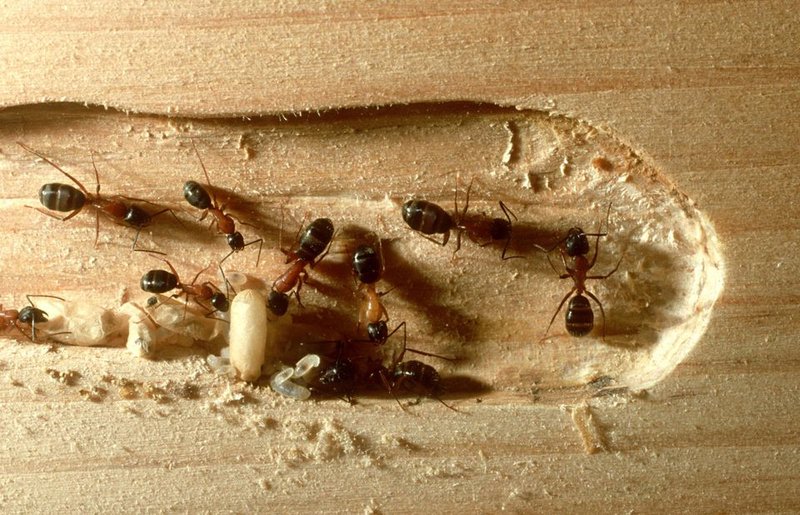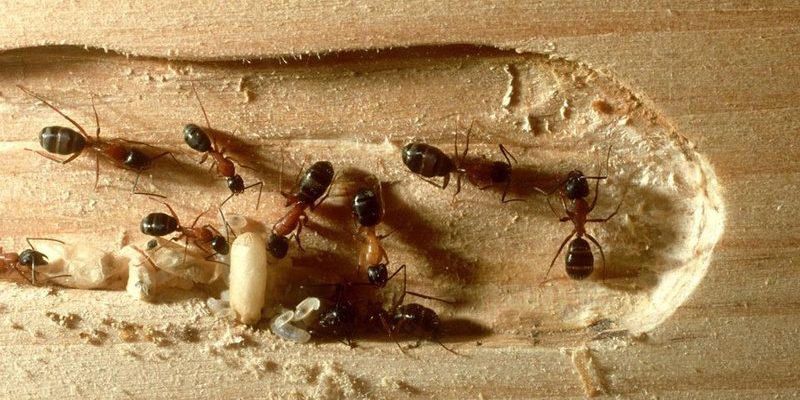
Think of carpenter ants like unexpected guests who show up and make themselves at home in your attic. They don’t mean to be rude, but they might just start rearranging the furniture—quite literally! So, let’s dive into what you need to know about these ants, including their behavior, potential risks, and how to handle them if they start invading your space.
What Are Carpenter Ants?
Carpenter ants belong to the family Formicidae and are one of the largest ant species, often measuring between 1⁄4 and 1⁄2 inch. They’re not just a nuisance; they’re also fascinating creatures with a complex social structure. Carpenter ants are known for their ability to hollow out wood to create nests. Unlike termites, which eat wood, these ants carve it out, leading to the misconception that they are benign.
You might spot them easily due to their black or reddish-black coloring. They also have a smooth, rounded back and large mandibles that help them chew through wood. Carpenter ants are mostly nocturnal, so if you see them wandering around during the day, it might mean that their nest is nearby.
Are They Dangerous?
When it comes to humans, carpenter ants are not dangerous in the same way that a wasp or a venomous spider could be. They don’t sting, and their bites are generally mild. However, if you disturb them or accidentally grab one, they can bite you. This bite might hurt and could cause a small red mark, but it’s usually not severe. Therefore, the real danger lies in what they do rather than what they can do to you.
Here’s the thing: carpenter ants can cause significant damage to wooden structures over time. If left unchecked, they can compromise the integrity of your home, leading to costly repairs. Think of it like ignoring a tiny leak in your roof—it might seem minor at first, but eventually, it can lead to mold and damage that requires major renovations.
How Do Carpenter Ants Cause Damage?
Carpenter ants cause damage by excavating wood to create their nests. They’re particularly attracted to moist or decaying wood, which makes your home’s framework a potential playground. As they chew through timber, they create tunnels that weaken the structure. This is why catching them early is so crucial.
You might notice signs of their activity, such as *sawdust-like* debris or frass. Think of frass as the carpenter ant’s version of litter; it’s made up of chewed wood and is often found near their entry points. You might also hear faint rustling noises within the walls, especially at night when they’re most active.
In severe cases, you could end up with structural problems, like sagging beams or weakened support columns, which can be a safety hazard. Once they’ve settled in, they can multiply quickly, so the sooner you address an infestation, the better.
How to Identify an Infestation
Identifying carpenter ant infestations early can save you a lot of headaches. Here are some key signs to look out for:
- Live ants: Spotting these black or reddish-black ants is the most obvious sign.
- Frass: Look for the sawdust-like material near wood sources.
- Squeaking noises: Listen for faint sounds coming from walls or woodwork.
- Wood damage: Inspect wooden structures for hollow areas and soft spots.
You might want to check areas that can be prone to moisture, like kitchens, bathrooms, or basements. If you start seeing signs of carpenter ants, it’s time to take action.
How to Get Rid of Carpenter Ants
If you find carpenter ants in your home, don’t panic. Here are some effective ways to deal with them:
1. Identify the Nest: This is crucial. Follow the ant trails to locate where they’re coming from. Use a flashlight to check attic spaces or dark corners.
2. Create a Barrier: Seal any gaps or holes in your home’s foundation, windows, and doors to prevent entry.
3. Use Baits and Traps: There are various commercial ant baits available that can lure ants in and poison them. Follow the instructions carefully.
4. Call a Professional: If the infestation seems severe, consider hiring pest control. They have the expertise and tools to handle it effectively.
You might also want to look into preventative measures, like keeping your home dry and reducing wood-to-soil contact around your foundation.
Preventing Carpenter Ant Infestations
Prevention is always better than cure, right? Here are some tips to help keep carpenter ants at bay:
- Keep Your Home Dry: Fix leaks and ensure proper drainage around your home.
- Trim Tree Branches: Keep branches away from your roof and siding, as they can provide a bridge for ants.
- Store Firewood Properly: Keep firewood at least 20 feet from your home and off the ground.
- Regular Inspections: Regularly check your home for signs of pests and act quickly if you notice anything unusual.
By taking these proactive steps, you can significantly reduce your chances of dealing with carpenter ants.
So, are carpenter ants dangerous to humans? The short answer is no—they won’t typically harm you directly. However, they can wreak havoc on your home if left unchecked. It’s like having a tiny construction crew working inside your walls, and while they may not be out to get you, the damage they can cause is real.
Stay vigilant and keep an eye out for signs of these pests. The earlier you spot a problem, the easier it is to handle. With a little awareness and preventive action, you can keep your home safe and sound from these wood-chewing intruders.

